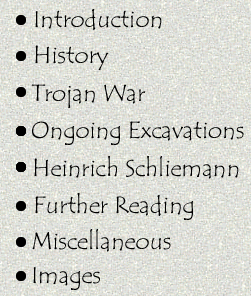
| Introduction: |
 The
city of Troy, which existed over 4000 years, is known as the center of
ancient civilizations. For many years, it was believed that the city was
only in stories until it was found. It is also called Ilion or, in
Latin, Ilium and is the site, almost universally accepted as the mound
now named Hissarlik, in Turkey. One of the greatest and
oldest works of literature, Homers' 'Iliad' was thoguth to have occurred
at Troy. The date of composition of this epic poem is unknown as it was
passed on in oral tradition centuries before being written down. The
epic tale is about the attack on Troy by the Greeks where they gained
access to the city by means of the Trojan Horse, described in Homers
subsequent work, 'The Odyssey'. After reading the Homeric poems
Heinrich Schliemann recognized the site and conducted excavations there
beginning in 1871. It is said that “the sixth layer of Troy is where
the Trojan War occurred, however, later discoveries by the Univ. of
Cincinnati expedition under C. W. Blegen indicated that the seventh
level was the Troy of Homer’s period.” The civilization of the Trojans
dates all the way back to the bronze age. The
city of Troy, which existed over 4000 years, is known as the center of
ancient civilizations. For many years, it was believed that the city was
only in stories until it was found. It is also called Ilion or, in
Latin, Ilium and is the site, almost universally accepted as the mound
now named Hissarlik, in Turkey. One of the greatest and
oldest works of literature, Homers' 'Iliad' was thoguth to have occurred
at Troy. The date of composition of this epic poem is unknown as it was
passed on in oral tradition centuries before being written down. The
epic tale is about the attack on Troy by the Greeks where they gained
access to the city by means of the Trojan Horse, described in Homers
subsequent work, 'The Odyssey'. After reading the Homeric poems
Heinrich Schliemann recognized the site and conducted excavations there
beginning in 1871. It is said that “the sixth layer of Troy is where
the Trojan War occurred, however, later discoveries by the Univ. of
Cincinnati expedition under C. W. Blegen indicated that the seventh
level was the Troy of Homer’s period.” The civilization of the Trojans
dates all the way back to the bronze age.
Troy has 9 separate cities and 47 different layers, each of which represents a different period in the history of Near Eastern civilization and cultural evolution. As a result of this variety, archaeologists excavating at Troy, study cultural remains spanning over five centuries. Having all of this at one site is an archeologist dream and allows them to see how the civilization of Troy changed over time. More importantly it allows historians to prove that ancient myths written about Troy are true.
|